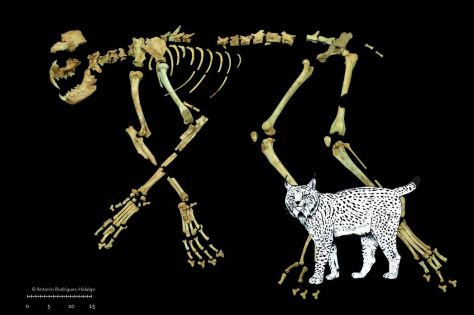NewsNext Previous
Prehistoric den of Iberian lynx identified for the first time
The study, led by Antonio Rodríguez-Hidalgo from of the Complutense University of Madrid and IPHES, sheds new light on the knowledge on Iberian lynxes
català – español – photos – video
The Cova del Gegant (Barcelona, Spain) is the first area where researchers identified the use of a cave as a denning site by Iberian lynxes. This is concluded in a study carried out by the Complutense University of Madrid (UCM), the Catalan Institute of Human Paleoecology and Social Evolution (IPHES), the University of Barcelona (UB) and the Catalan Institute of Palaeontology (ICP).
The study, published in Nature‘s Scientific Reports, concludes that Cova del Gegant was used recurrently by the Iberian lynx as a breeding den 30,000 years ago. The lynx was a very common medium-sized feline in the Palaeolithic record of the Iberian Peninsula, but previous studies on this carnivore had not described its behaviour in the past.

Through taphonomy and zooarchaeology, researchers proposed that lynxes used the Cova del Gegant site as a shelter for their kitten. More than a hundred lynx bones of different ages, together with thousands of bones of their preys, mainly rabbits and small birds, were recovered and studied. Fossilised scats (coprolites) were also recovered and the study of its content enabled researchers to identify the lynx diet.
The identified species in the Cova del Gegant corresponds to the current Iberian lynx (Lynx pardinus), one of the most endangered felines in the world. Nowadays, the population is basically found in Andalusia (mainly in Doñana), but also in the southwestern area of Spain and some parts of Portugal. Today, there is not an established population in northeastern Spain (Catalonia and Aragon), but as shown in this study, lynxes were abundant in the past. Although the climate and ecosystem conditions of the area are suitable for the lynx population, lynxes became extinct due to the anthropogenic pressure. In fact, in 2018, a free-ranging lynx, known as Litio, travelled from the south of Portugal to the metropolitan area of Barcelona.
So far, biologists and ethologists have studied the behaviour and diet of the extant Iberian lynx but current studies bear in mind that their behaviour can be conditioned by the human-modified environment. The archaeological research conducted in Cova del Gegant enabled researchers to study the guidelines of a lynx community from the Palaeolithic, a time when the anthropic pressure was rare.
The study sheds light for the knowledge of the Iberian lynx. First, because its presence in other sites can be result from the use of these caves as a shelter. Second, because the abundance of rabbis and birds in certain sites could be the result of lynx activity instead of other suggested agents, such as prehistoric humans.
The singularity of Cova del Gegant lies in the preservation of the remains, accumulated in a unique layer, and has not been modified by any other carnivores. This enables establishing a set of features to identify lynx dens in fossil records, criteria that are useful for future archaeological studies. Therefore, these features can be summarised as: abundance of rabbits and birds remains, a high number of lynx bones from different ages-at-death, fractures on rabbit bones and lynx bites -mainly inflicted by cubs- in prey bones, and abundance of coprolites.
Cova del Gegant site
Cova del Gegant (Giant’s cave) is located in the municipality of Sitges, the site is one of the scarce Middle Palaeolithic record of the Iberian Peninsula where Neanderthal fossil remains have been found over the last decades. Today, the cave entrance is partially flooded as a consequence of the sea level fluctuations. Thirty thousand years ago, when Iberian lynxes used the cave, the climate was colder than today and the Mediterranean sea level was between 80m and 120m below the current level, therefore a costal platform emerged in front of the cave, a suitable area for the Iberian lynxes to live and catch their preys.
The study, led by Antonio Rodríguez-Hidalgo from the Prehistory, Ancient History and Archaeology Departament of the Complutense University of Madrid and IPHES, sheds new light on the knowledge on Iberian lynxes.
The archaeological excavations, funded by the Archaeology and Palaeontology Services of the Catalan Government, have been carried out since 2007 by the Prehistoric Studies and Research Seminar (SERP) of the UB, and are led by Montserrat Sanz and Joan Daura, from.
This study was carried out as part of the Taphen project, an international network on taphonomy at a European scale, and was conducted apart from the main author, by Montserrat Sanz and Joan Daura (University of Barcelona) and Antonio Sánchez Marcos, from the Catalan Institute of Palaeontology Miquel Crusafont (ICP).
Article reference
Antonio Rodríguez Hidalgo, Montserrat Sanz, Joan Daura and Antonio Sánchez Marcos. Taphonomic criteria for identifying Iberian lynx dens in quaternary deposits. Scientific Reports, April, 2020. https://doi.org/10.1038/s41598-020-63908-6


